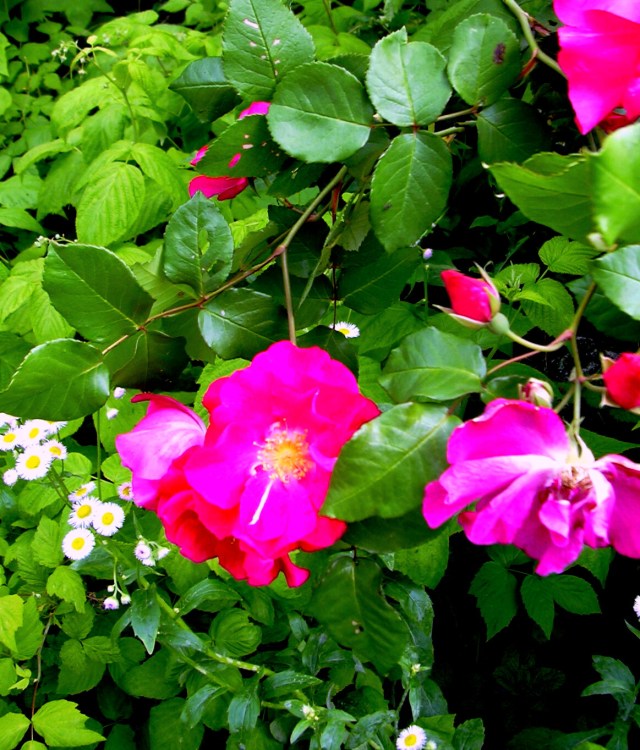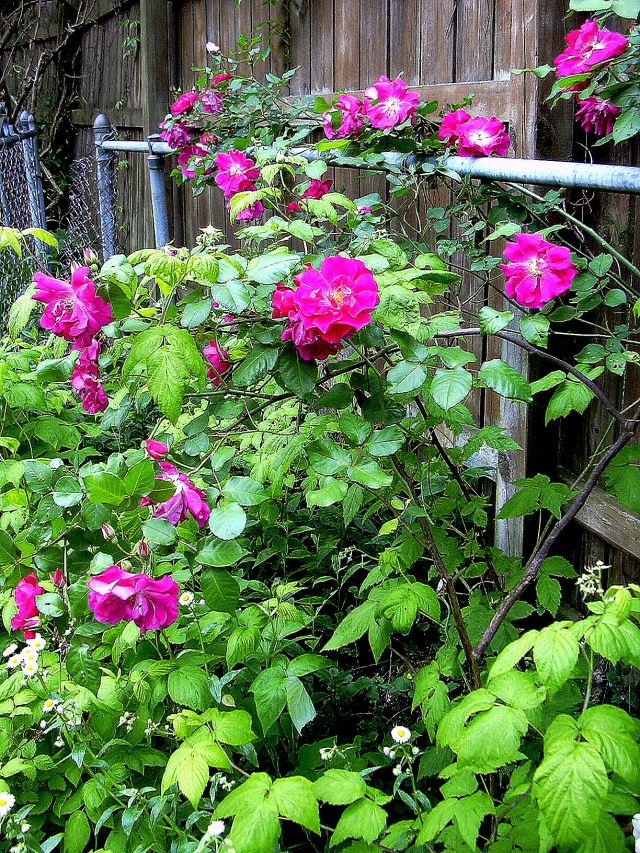On thorns
I love the fact that roses have thorns. I think their silky-soft petals, gorgeous colors, and sensuous scents coupled with razor-sharp, bloodthirsty thorns make a piquant combination. But not everybody feels the way I do. So here are some recommendations for people who can’t hack the thorns.
There are some really good roses that do not have thorns, or that don’t have many thorns, or the thorns they do have are very tiny. In fact, some are good enough to merit a share in the limited space in my yard. You can get any of these at Antique Rose Emporium, Heirloom Roses, or Petals from the Past.
Thornless roses I have grown and recommend
Shrubs
Marie Pavie
The photo above shows the flowers of Marie Pavie, a short, bushy shrub that’s always thickly covered with leaves and most of the time also covered with clusters of small pinkish-white flowers.
Here is another picture of a plant in my back yard, so you can see what the plant looks like. It’s about four and a half feet high and four feet wide, since I never bother to prune it to keep it at a certain size.
Nur Mahal
Nur Mahal blooms in clusters of reddish-fuchsia flowers. It grows a little bigger, maybe 5-6 feet tall unless you prune it. The header at the top of this blog is a Nur Mahal that used to be in the front yard. Nice plant, no thorns, blooms fairly constantly in the sun.
I planted this rose too close to the sidewalk and, I will confess, I accidentally killed it by moving it. It was too big and established for me to move. But I had started another plant that is in the backyard.
This is a flower cluster just starting to bloom:
This next picture shows more of the whole plant. Keep in mind this rose is planted against the northeast side of an eight-foot privacy fence, so it doesn’t get as much sun as most roses demand:
Climbers
Ghislaine de Feligonde
Yes, the golden star of my blog is also thornless. I checked. I don’t think of her as a thornless rose, but all there are are a few prickles, like the ones on a thornless raspberry, and some prickles on the back of the compound leaf stem that would likely snag your pantyhose if you brushed against them.
She is a small polyantha climber that blooms in clusters of a dozen or so multi-petaled blooms that open apricot and fade to a lemon chiffon color.
Just opened:
The flowers on any cluster open at different times, so the whole plant becomes a tapestry of yellow and apricot. This picture shows it best:
She’s a great plant. Does not lose many leaves to black spot or go into a pout in August.
Zephirine Drouhin
Zephirine has the most gorgeous smell and the most beautiful color of all the roses I grow. The smell is a tea rose fragrance that has lemon in it. The color is a very peculiar fuchsia that is both warm and cool at the same time. For this reason, the flowers are fantastic in arrangements, though — like all roses that make good garden plants as well as flowers, rather than “flower cows” that make long-stemmed roses on butt-ugly plants — the stems are short.
She also is thornless — really thornless. I mean, like, naked.
She is a Bourbon climber from 1870. The exotic name suggests a lovely mistress, one so gorgeous that only somebody who obtained his money very illegally could possibly afford to keep her.
This is Zephirine:
Note the black spots on the leaves. This is partly because she is now in the shade of a hackberry tree that has gotten really big. I mean, so close to the tree that she is climbing up a branch of it. Most roses will not put up with this kind of nonsense. Many will just decline and die. She merely gets some black spot, which causes leaves to yellow and then fall off, from the stress of shade. She would do better in the sun — there are three plants on a fence on Old Frankfort Pike that are constantly covered with leaves and produce more flowers because they get more sun — but is too big to move. [See “Nur Mahal” above].
During spring flush of bloom:
Peggy Martin
I don’t have a picture of Peggy Martin, because she is very small at this point, although blooming heartily.
As you can see, she grows like a hog. The rose clearly gets BIG. And fast. Every picture I’ve seen shows a fence, trellis, arch, or other structure smothered in foliage and blossoms. Mine never stopped for breath after I planted it , but started shooting out canes blooming with clusters of one-inch pink roses.
This is the rose that survived being underwater two weeks after Katrina. The lady at Petals From the Past said she is a polyantha [like Ghislaine, with small foliage and clusters of petite flowers, although the plant may build up to get huge] and so should be fine even north of Zone Six.
Fortuniana
This rose, alas, will not grow north of Zone 7. This plant is in Austin, Texas, in Zone 8. Unlike all the other roses I’ve mentioned, this guy blooms once a year, like an azalea. Gorgeous and will get to — Wow, I’ve seen it smothering a grove of bamboo on Austin’s South 1st Street at Cardinal Lane, just north of the exit for Ben White Boulevard. It covers 12-foot bamboo over a space about 35 by 50 feet. It’s at a place called Mercury Hall, an old house used for weddings, concerts, and other events. I can’t believe I’ve never taken a picture of it in March, when it blooms, and I can’t access one online. But check out their garden anyway.
There are more thornless roses that I have grown and recommend, and once I locate the photos, I will add them to this post, so check back soon.











Wow. What a beautiful blog. The roses are amazing too.
Thanks!!